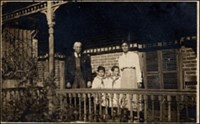- Lesson Plan (31)
- Distance Learning (5)
- Field Trips (3)
- Student Activities (3)
- Guest Speakers (1)
- Other Education Materials (1)
- New Orleans Jazz National Historical Park (6)
- Andersonville National Historic Site (3)
- Palo Alto Battlefield National Historical Park (3)
- First State National Historical Park (2)
- Fort Scott National Historic Site (2)
- Gateway Arch National Park (2)
- Ulysses S Grant National Historic Site (2)
- Acadia National Park (1)
- Belmont-Paul Women's Equality National Monument (1)
- Show More ...
- Social Studies (40)
- Literacy and Language Arts (21)
- Science (9)
- Math (4)
Showing 45 results for Jim Crow Laws ...
Law Merit Badge
- Type: Other Education Materials
- Grade Levels: Middle School: Sixth Grade through Eighth Grade

Does protecting the law involve bravery? Does telling the truth equal courage? Investigate the judicial system and its important role in our society. Scouts re-enact a historic trial and debate contemporary issues. An attorney and a National Park Service Law Enforcement Ranger will discuss their roles and responsibilities in society.
Exploring Humanitarian Law
Law and Order: Does the punishment fit the crime?
- Type: Lesson Plan
- Grade Levels: Upper Elementary: Third Grade through Fifth Grade
At the end of this activity, the student will be able to: -Summarize the establishment of state and national governments. -Explain the structure and function of the legislative, executive, and judicial branches of the federal government.
Segregation Laws in the 1800s: Williams v. Bellefontaine
- Type: Field Trips
- Grade Levels: Upper Elementary: Third Grade through Fifth Grade

In 1867, Neptune and Caroline Williams sued the Bellefontaine Railway Company over its discriminatory policies regarding African Americans. In a dispute with the streetcar operator, Mrs. Williams was hurt. The Williamses sued at the St. Louis Courthouse and won their case, but with a twist. Will students reach the same verdict?
The Wirz Trial: A Mock Trial Lesson Plan Examining the Laws of War
He Aha Lā He Kūkulu?
A Town Divided
- Type: Lesson Plan
- Grade Levels: Upper Elementary: Third Grade through Fifth Grade

We live in a nation of laws. Our rights are protected by the Constitution. There are national laws, state or territorial laws, and local laws that exist to protect those rights. What happens when laws are passed that restrict those rights? What then? What happens when those in power choose which laws to enforce and who to administer justice to?
Lesson 2 - THE SOCIAL CATEGORIES OF RACE
- Type: Lesson Plan
- Grade Levels: High School: Ninth Grade through Twelfth Grade
Your Day in Court: Bleeding Kansas Courtroom Program
- Type: Lesson Plan
- Grade Levels: Upper Elementary: Third Grade through Fifth Grade

Is it fair to make decisions based on biased laws? This program recreates a court case that was tried at Fort Scott in the 1850s, The issue involved a land squabble between two men on opposite sides of the political spectrum. The court was left to decide the issue based on territorial law that favored the proslavery side based on the fact that proslavery men held the majority in the territorial legislature and decided territorial law in their favor.
- Type: Lesson Plan
- Grade Levels: Upper Elementary: Third Grade through Fifth Grade

Guiding Questions: What is stratigraphy? What is the law of superposition? How can archaeologists study stratigraphy to determine the age of archaeological objects? Students will: Explain what stratigraphy is. Describe the law of superposition. Understand how stratigraphy can be used to determine the age of archaeological objects.
- Type: Lesson Plan
- Grade Levels: Middle School: Sixth Grade through Eighth Grade

What would you do if you found a Texas tortoise in the middle of the road? Or if your friend broke the law? In this lesson, students discuss their own values and ethics as well as the importance of respecting the values of others. Next, students learn about laws protecting the state-threatened Texas tortoise. Afterwards, they discuss how their values influence their behavior in various situations.
“Nickels to Dollars”: Maggie L. Walker's Quest for African American Economic Empowerment
- Type: Lesson Plan
- Grade Levels: Middle School: Sixth Grade through Eighth Grade

Students will pretend to go back in time to 1903 when Maggie Walker chartered the St. Luke Penny Savings Bank. They will use a 3D replica of, or the computer aided models of, the 1927 Maggie Walker collection bank to learn about the economic tools African Americans used to resist discrimination and uplift their communities during the Jim Crow era. Este plan de clase con actividades incluido también está disponible en español.
Good Intentions
- Type: Student Activities
- Grade Levels: Middle School: Sixth Grade through Eighth Grade

In this activity, students will read about the loop hole and the subsequent repeal of the 1881 law and its replacement by a 1914 law that allowed below dam hatcheries to be built instead of waterways. The students will then compare the early economic gain from the dam to the Olympic Peninsula in the form of hydropower with the loss of the salmon and write an editorial for The Port Angeles Evening News either supporting the dam or supporting the salmon.
A Balancing Act: Delaware and the Constitution
- Type: Field Trips
- Grade Levels: Middle School: Sixth Grade through Eighth Grade
Students will participate in and understand the legislative process through participating in an interactive program at The Old State House based on the process of passing a law though the branches of government. This program takes place around The Dover Green.
Rights, Rules and Privileges
- Type: Field Trips
- Grade Levels: Upper Elementary: Third Grade through Fifth Grade
This program explores the differences between rights, rules and privileges and the need for government and laws. Students have to determine if something is a right, a rule or a privilege. This program takes place at the New Castle Court House Museum.
Behind the Flat Hat: Ranger Careers
- Type: Distance Learning
- Grade Levels: Upper Elementary: Third Grade through Fifth Grade









